A Few Words About Living in the Past
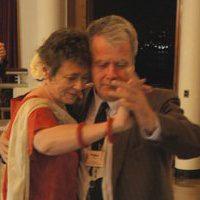 I received yet another email from a TV producer looking for people who live entirely in some sort of historical way. She gave me the sense that she really didn't understand us, and I fear that she was looking for subjects for a, not to put too fine a point on it, freak show like those I saw a few years back from the BBC. Here's how I responded:
I received yet another email from a TV producer looking for people who live entirely in some sort of historical way. She gave me the sense that she really didn't understand us, and I fear that she was looking for subjects for a, not to put too fine a point on it, freak show like those I saw a few years back from the BBC. Here's how I responded:
I understand there are some people who try to live entirely in some sort of "retro" way, but I don't know any. Everyone I know cherry picks from the past: we draw from the past the things we find lacking in the present, but we are perfectly willing to take advantage of modern technology and live in the real world. Most of us prefer not to live in a world with the disease, violence, bigotry and gender inequality that was all too common in the past, and there's few of us would turn down a shot of antibiotic if we had a serious infection.
Different people cherry pick different things. A lot of folks love the fashions of the past and enjoy the sense of occasion that really dressing up lends to any activity - something that is sadly lacking in our hyper-casual society. Many (and these groups contain lots of the same people) love the music and perhaps dance of the past - a time when songs were finely crafted and dances gave you a real connection to your partner.
Jazz Age Dance - Apologia
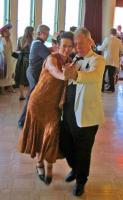 The initial motivation behind this project, to understand the most popular dances of the "Jazz Age", was frustration and confusion. THE big dance of the time was the Fox Trot, but the Fox Trot as I understood it just didn't seem right.
The initial motivation behind this project, to understand the most popular dances of the "Jazz Age", was frustration and confusion. THE big dance of the time was the Fox Trot, but the Fox Trot as I understood it just didn't seem right.
- The Fox Trot classes I had taken felt complicated and contradictory with seemingly random assortments of "quicks" and "slows" and memorized routines, some of which required me to count (I've never been good at math). It felt like I was getting pieces of a puzzle, without understanding how they fit together.
- The Fox Trot as I understood it and as I saw it performed by trained dancers, looked a bit like Fred and Ginger, but didn't look much like what I saw "regular folks" doing in old movies - and I have always been a bit more interested in regular folks rather than stars
- My Fox Trot wasn't much fun. How could such a dance have been so dominant and universally popular? How was it that this not very appealing dance (as I with my limited understanding understood it) was THE dance of the Jazz Age?
5. 1930s Rumba
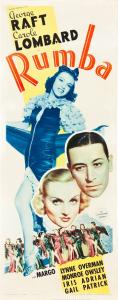 The 1930s saw the introduction of the Rumba (also spelled "Rhumba") to the North American and European ballroom. It was the result of applying a European ballroom dance vocabulary to a Latin beat. It began around 1930, and gradually grew in popularity through the '30s. By around 1935, it was a full fledged dance craze - though it never reached the heights of popularity enjoyed by the Foxtrot.
The 1930s saw the introduction of the Rumba (also spelled "Rhumba") to the North American and European ballroom. It was the result of applying a European ballroom dance vocabulary to a Latin beat. It began around 1930, and gradually grew in popularity through the '30s. By around 1935, it was a full fledged dance craze - though it never reached the heights of popularity enjoyed by the Foxtrot.
When it first arrived on the scene, dancers applied familiar moves to a new beat. In the videos in this collection, there is a sophisticated group of dancers from 1930 using Tango/Foxtrot styling to a Rumba beat.
While the classic Rumba box-step was being demonstrated by dance teachers as early as 1930, it took a few years for a distinctive style of Rumba to emerge among the general dance population that was significantly different from the Tangos and Foxtrots that came before, and part of its appeal was probably that it was a departure from the settled norms of the 1930s ballroom. First of all, unlike the "just walking" dances that had predominated since the Turn of the Century, it had that specific step.
The second was the tendency of the partners to separate, and even when they were together they had an open frame and were seldom in the close embrace of the Foxtrot. Underarm turns were common and "throw outs" were a frequent feature, and the dancers even separated to do their own little personal Rumba before linking back up to their partners.
The Rumba also had an element of showmanship, of showing off, that had definitely not been part of mainstream social dancing. Certainly Swing dancers were all about putting on a show, but Swing, with its popularity among African Americans and the white kids who emulated them, was not seen in the clubs and ballrooms of adult white "polite society".
Thos Wilson's Quadrille Instructor - Ca 1816
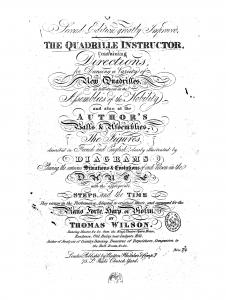
The Quadrille Instructor,
Containing Directions, for Dancing a Variety of New Quadrilles, as Introduced at the Assemblies of the Nobility and also at the Author's Balls & Assemblies.
The Figures, described in French and English, clearly illustrated by Diagrams Shewing the various Situations & Evolutions of each Person in the Dance, with the appropriate Steps and the Time they occupy in the Performance.
Adapted to original Music, and arranged for the Piano Forte, Harp, or Violin,
by Thomas Wilson
This compact book of instructions discusses the quadrille at the time it was being invented. In geometry, these early quadrilles were very much like later Victorian quadrilles (and American Square Dances for all that). However, the Victorians had largely given up on the steps that are such an integral part of the Regency Quadrille.
The publication date is an estimate. The book is not dated, but the text refers to a long forgotten French opera about the Duke of Wellington, and it seems unlikely that the French would be writing operas about the Iron Duke before the Battle of Waterloo - and also mentions "Treasures of Terpsichore", which is dated 1816.
8. Bal Musette: Parisian Dance of the Jazz Age
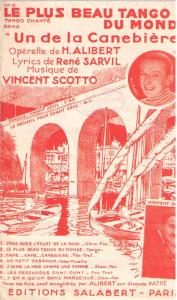 I include this as a distinct heading, since Paris in the "Jazz Age", while absorbing the influences of the US and other countries, had its own distinctive style of dance. Given that Jazz Age Paris was the world capital of fashion, art and intellectual ferment, I think it appropriate that a survey of Jazz Age dance should take a moment to look at how people were dancing in the world of Chanel, Hemingway, Piaf and Picasso. The style of dancing seems to have persisted with very little change until the inexorable march of Rock and Roll eclipsed it in the '60s.
I include this as a distinct heading, since Paris in the "Jazz Age", while absorbing the influences of the US and other countries, had its own distinctive style of dance. Given that Jazz Age Paris was the world capital of fashion, art and intellectual ferment, I think it appropriate that a survey of Jazz Age dance should take a moment to look at how people were dancing in the world of Chanel, Hemingway, Piaf and Picasso. The style of dancing seems to have persisted with very little change until the inexorable march of Rock and Roll eclipsed it in the '60s.
While lumping it all under the title of "Bal Musette" may not be precisely correct, since there was plenty of dancing taking place in France in places other than Bals Musettes (upscale nightclubs, private parties etc. for example), it is a convenient shorthand for this distinctive French style.
A "Bal Musette" was an informal sort of dance, hosted in bars, restaurants and dance halls, open all to social classes and often with a decidedly down market feel. It was danced on a small dance floor with a modest band (trio, quartet, quintet) that nearly always featured a "musette" accordion.
Elizabethan Dining
The Ample Pleasures of the English Table
The Elizabethan, like ourselves, generally ate three meals a day. The first was breakfast, which was eaten shortly after rising, but not before attending morning services (farmers wouldn't have time in the morning to attend services any day but Sunday, but pious townsmen, the gentry and their servants often did go to the chapel daily). Breakfast was a small, simple meal, generally consisting of cold foods, as the cook fires were just being lit as the breakfasters were rising. Leftovers, eggs, butter, bread and small beer were commonly taken with breakfast.
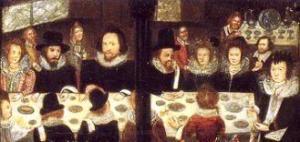 But, since breakfast was by definition eaten early, those who did not rise early did not eat it. Unless they were traveling or fond of the hunt, nobles generally did not rise early enough to eat breakfast, and dispensed with it in favor of a hearty mid-day meal. Working men and women however, who rose with the sun, seldom failed to fortify themselves against the day.
But, since breakfast was by definition eaten early, those who did not rise early did not eat it. Unless they were traveling or fond of the hunt, nobles generally did not rise early enough to eat breakfast, and dispensed with it in favor of a hearty mid-day meal. Working men and women however, who rose with the sun, seldom failed to fortify themselves against the day.
List of English Country Dance Groups in Southern California
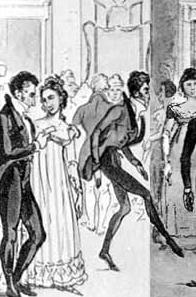 Thanks to Sparky Sotcher for compiling this list
Thanks to Sparky Sotcher for compiling this list
Information as of July 4 2012
- Anaheim -- 3rd Saturdays, http://www.ocecd.sdecd.org
- Calabasas-Agoura -- Parrot Cove Morris. Contact Deborah Castillo for meeting times and info. Email Tahoe1720@AOL.com
- Culver City -- 2nd & 4th Sundays, http://www.caldancecoop.org
Video of the November 2011 Victorian Grand Ball

This is a 5 minute video of the November 26th Social Daunce Irregulars Victorian Grand Ball. Purists beware. The last dance is not any dance in particular, but a pastiche of three different set dances, done to a completely unrelated piece of music.

